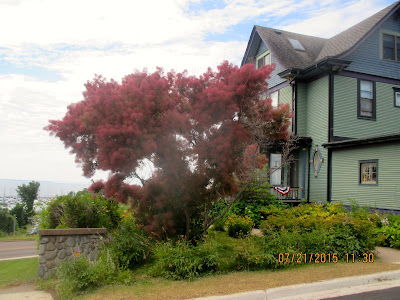 |
| FALSE SP[IREA, A LARGE, SPREADING SHRUB... |
 |
| ...LARGE, CREAMY-WHITE FLOWER CLUSTERS... |
 |
| ...BIG, PINNATELY COMPOUND LEAVES |
Thursday, 8:00 AM. 67 degrees F at the ferry dock, 63 on the back porch. Wind SW, calm with light gusts. The sky is partly filled with high, wispy clouds. The humidity is 84% and the barometer is falling precipitously, now standing at 29.89". We will probably get a rain shower this evening.
Yesterday I continued pruning shrubs and trees and trimming grass, and will finish those tasks this morning. I like to create rooms and vistas as I prune mature trees and shrubs. I feel that a landscape, no matter how small, should have niches and coves to sit in, and vistas and focal points to view from each vantage point. It is an undertaking that demands time and patience of the pruner, and an eye for the broader outlook and borrowed views, as well as the closer details. It can be a very creative and enjoyable task.
Yesterday while eating lunch on the porch I swatted a flying yellow jacket with my hands. He evidently had a fierce objection to my doing so, as he really nailed my right hand hand, which remains pretty well swollen this morning.
The false spirea, Sorbaria sorbifolia, in the Rose Family, is closely allied with the genus Spirea, and the genus and species names relate to Sorbus, the mountain ash genus, which its leaves resemble. It is also closely related to Aruncus, the goat’s beard shrub, which I talked about a few days back. False spirea is native to northeast Asia, and is hardy to Zone 2. It is a very large, spreading plant useful in shrub borders and for screening.
It blooms profusely in mid-summer and is interesting in form and foliage, but it spreads by runners and could be invasive in the smaller yard. Although not native, it has a very naturalistic appearance. It might be used more than it is in the landscape, as it is quite an imposing plant, and has large, colorful blooms, first creamy white and later turning brownish, and lush foliage.
The shrubs pictured are on the corner of 8th Street and Manypenny Ave., and a large planting is naturalized along Hwy. 13, south of Bayfield, near the bridge over Pike's Creek.



























































